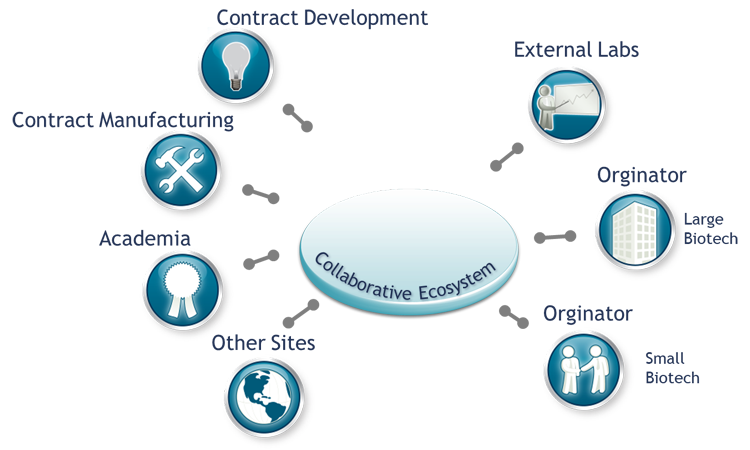Collaborative Data Analytics in the Biotech Industry


Biotech has a huge impact on our world. Biotech innovations provide novel treatments to cure diseases such as cancer and Alzheimer’s syndrome. Biotech brings new, sustainable products to the market. Biotech companies already conquer the world’s beef and material market with sustainable alternatives (e.g. Impossible Foods®).
In this innovative and high-impact industry, collaboration is everything: Biotech innovators collaborate with external manufacturers to rapidly scale and bring their product on the market or to the clinic. Specialized consultants to help with regulatory, facility or scale up or clinical questions. Manufacturing processes are transferred many times from site to site, organization to organization. Academia create innovations on products and technologies. Biotech companies contract highly specialized external laboratories to characterize the quality of the biological products. Collaboration is worldwide, distributed over continents and across companies with a couple of dozens and multiple thousand employees. In this huge joint collaborative effort, easily more than 1000 industry experts from more than 20 different companies and countries collaborate on one product.
With so many companies, people and stakeholders involved, also come challenges. Product and process knowledge is distributed between collaborators and different companies. Information and knowledge are generated (and lost) in and beyond company boundaries. How to keep track of that? Data forms the web between biotech collaborators. Collaborators in the biotech industry, whether they are innovating or producing, document their research and manufacturing process through the generation and sharing of data.
Collaborative data analytics
The aim of collaborative data analytics is to integrate people, information and processes. Simulations showed that R&D costs can be cut by 50% by following the right collaborative data analytics methodology, while helping manufacturing decrease the number of failed batches by one third.
In this article, we take a look into new collaborative data analytics technologies and how they are applied in successful biotech R&D and manufacturing.

Collaborative Data Analytics: Technologies
Statistics & Machine Learning
Statistics & machine learning forms the backbone of data analytics. Based on your objective, follow the right regulatory accepted workflows to realize bioprocess design, scale-up, process validation or continued process verification. Bring everybody on board to contribute in design and roll-out. Collaborate across departments with R&D, quality, Statistics, MS&T and Validation.
Data Wrangling
Objectives always come first. May it be process optimization, process design, robust technology transfers or further down the lifecycle continued process verification, data needs to be processed differently. Be sure you know your goal before starting your collaborative data analytics journey. Then, start to focus on the relevant data to achieve your goal. This is data wrangling. Let algorithms work to model data into projects, include and exclude relevant data automatically. Then, select the people that need to create value from the contextualized data and let them engage with the data.
Data Integrity: Blockchain
Data integrity is a must. To make sound decisions, you need to trust your data. Not only you, also your regulators expect data integrity. Blockchain offers the potential to integrate data integrity by design. To date the only technology out there that can guarantee 100% data integrity.
Partner Gateways
In biotech, every collaborative partner contributes to the success of a product. Contribution also involves ways to contribute data to the R&D, tech transfer or monitoring processes. Collaborators need workflows to contribute data and engage with you in data analytics. Partner gateways handle the approval workflow, chase missing data at collaborators automatically and involve external statisticians or data experts for third party views.
Cognitive Assistants
Today, you interact with software through graphical user interfaces. Buttons, lists, filters enable you to interact with software. It is often challenging and time intensive to find the right information by navigating through increasingly complex buttons and filters. Soon, cognitive assistants will make your life easier by offering completely new ways to interact. Cognitive assistants will send you your personalized dashboards, push the information you need to your smart watch, identify optimization potential in your processes. The models behind this information are digital twins – digital replicas of your manufacturing processes.
“What is the estimated shelf-life of my product?” Information that will be available soon within seconds based on cognitive interfaces that interact. But you will not only use cognitive agents for an intuitive access to data. Cognitive agents will tell you what to do next in your R&D and manufacturing data analytics workflows, identify risks and set alerts to ensure compliance. Cognitive Agents interact with people and facilitates your daily work.
Cognitive agents interact with people and facilitate your daily work. Cognitive agents are already available for consumer applications (e.g. helping to understand how consumers react on products, brands and marketing agents) and now entering the business world featured by industry 4.0. The race has started.
Summary
Data analytics can create value for biotech companies. No doubt. Accelerated process development. Investigation & troubleshooting. Operations excellence. Assess optimization potential. Just to name a few use cases. But data is nothing without the people analyzing it. That’s where collaborative data analytics come into play. While data analytics was formerly for data specialists, collaborative data analytics is for everybody in the organization. Everybody from within or beyond your organizations contributes to the success of data analytics to realize your company goals.
The ISPE Biopharmaceutical Manufacturing Conference brings together key international thought leaders to discuss the latest developments in the biopharmaceutical sector.



